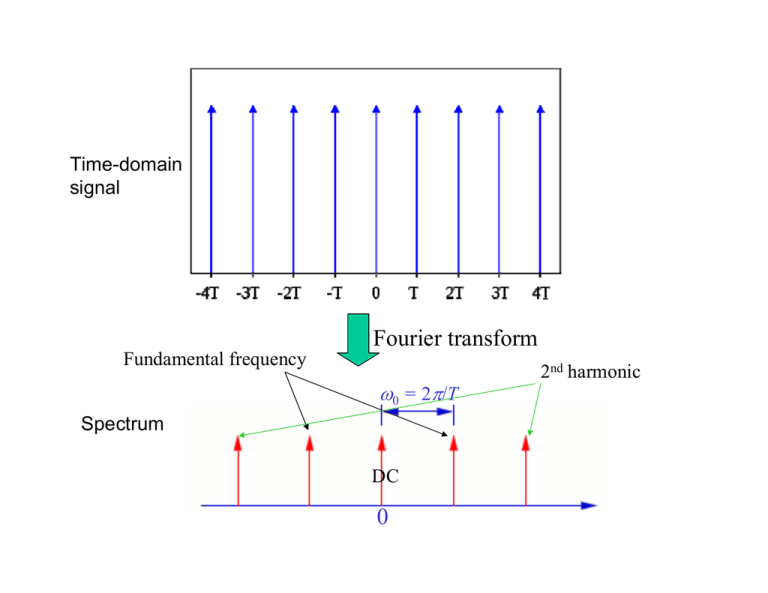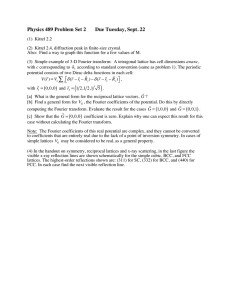Fourier transform 0
advertisement

Time-domain signal Fourier transform Fundamental frequency 0 = 2/T Spectrum DC 0 2nd harmonic To find the fundamental frequency component: In contrast, cos 20t cos 0tdt 0 The 2nd harmonic is orthogonal to the fundamental. (t nT ) cos 0tdt To find the 2nd harmonic: (t nT ) cos 20tdt Since the spike is infinitely sharp, we have the nth harmonic as a spike in the frequency domain, no matter how big n is. (t nT ) cos n0tdt Therefore, Time-domain signal Fourier transform Fundamental frequency 0 = 2/T Spectrum DC 0 2nd harmonic How do we find the spectrum of a periodic signal like this one t p is frequency if we know Fourier Transform You may use f or . Just need to know what you are talking about. (Figures taken from http://www.roymech.co.uk/Useful_Tables/Maths/fourier/Maths_Fourier_transforms.html) Images taken from Web. Function of x, but the math is the same; actually that’s what we really will talk about. It turns out 0 = 2/T Fourier Transform T t Spikes disappear. We’ll revisit this when we talk about diffraction patterns. because Fourier Transform A bit more math if you were into signals and systems: In the time (or space) domain: Convolution: f (t ) (t ) f (t ) Construct the pulse train: f (t ) (t nT ) f (t nT ) n f1 (t ) f 2 (t ) f (t ) (t nT ) f (t nT ) Shift: Fourier Transform n F1 ( ) F2 ( ) The math is the same for space (as for time) a x Fourier transform 2/a k 0 or 1/a 0 Spatial frequency You may replace the spikes with points a In real space: We call a period a “unit cell.” Infinite choices for the unit cell. Fourier transform In reciprocal (or k-) space: 2/a 0 k Just like you can have a pulse train in time domain T the unit cell can have an internal structure Again, you have infinite choices defining the unit cell. Fourier transform (A computer can do FFT) 2/a 1 spot 0 spot 0 k 1 spot The intensities of the spots vary due to the unit cell internal structure, just like in the spectrum of a time-domain pulse train: t Nature’s way of doing Fourier transform: Diffraction Shine a beam (X-ray) with many wavelengths (broadband) To have constructive interference between reflections by all atoms/unit cells: a 2 n 2 2a k n k n 2 2a The k of the photon The k (vector, proportional to its momentum) of the photon is change upon reflection by 2 2 k k f ki 2 n n a 2a 2/a 0 k You see, the Fourier transform is just a “spectrum” of k. It feels like the lattice gives the photons momenta n(2/a). You have a kind of “momentum conservation.” You can shine a monochrome beam in a second dimension (more like the way that’s actually practiced) z x In some directions, you have the right k for constructive diffraction. • Momentum conserves only in the x direction. • kz is free to keep kf = ki. • The pattern is a bunch of parallel lines, k • Each standing for a kx, • Set by the lattice. • The pattern is a spectrum of kx, • Representing the spatial frequencies (momenta) of the lattice. Fourier transform in 2D b a Real Reciprocal ab 2/b a2 b2 (00) 2/a 2 a 2 b 2 ab Real Reciprocal (00) 3 a 2 a 2 4 3 3a a 2 Diffraction by 2D Lattice • The pattern is an array of spots, • Each standing for a k//, • Set by the lattice. • The pattern is a spectrum of k//, The wave may be an electron beam. We have talked about the very basics. Now it should be easy for you to read about the details of LEED and SAED. • Representing the spatial frequencies (momenta) of the lattice. • Momentum conserves only in the xy plane. • kz is free to keep kf = ki. Examples from my group’s research Lei Liu et al, Science 343, 163 (2014). STM images. The computer does the Fourier transform (FFT) to the atomic-resolution images. STEM image. Not really atomically resolved, but FFT shows pattern. Wait a minute, is the graphene “lattice” a lattice? zigzag armchair Reciprocal Real armchair zigzag Patterns by diffraction BN on Cu(100) 0.25 nm Only 3 of the 6 spots can be seen 0.25 nm Lei Liu et al, PNAS (under revision review). 6aBNcos30 5aCu If you adjust the contrast, you see more spots Moiré Patterns and Supercells 2 3 6 supercell 1/6 Supercell, larger period, smaller frequency. 1/3 1/2 6aBNcos30 5aCu Macroscopic Moiré in Min H. Kao Building Disclaimer We’ve seen the beauty of periodic things. We study them probably just because they are simple and we have the mathematical tools, not necessarily because they are “better.” What the physicist calls “yucky and squishy things” may outperform the “beautiful” ordered things. That squishy thing in Sheldon’s head runs on only 20 W and outperforms any supercomputer. From last lesson Macroscopic Moiré in Min H. Kao Building How does this pattern form? Two identical honeycomb patterns, rotated with regard to each other Adapted from http://www.physics.rutgers.edu/~aluican/research.html Two (slightly) mismatched honeycomb patterns orientationally aligned to rotated from each other Moiré, superlattice: Larger period over small periods and many more high-profile publications... The importance of periodicity. We will talk about electrons in periodic things.






